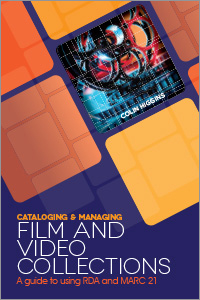Primary tabs
You don't need to be an ALA Member to purchase from the ALA Store, but you'll be asked to create an online account/profile during checkout to proceed. This Web Account is for both Members and non-Members. Note that your ALA Member discount will be applied at the final step of the checkout process.
If you are Tax-Exempt, please verify that your account is currently set up as exempt before placing your order, as our new fulfillment center will need current documentation. Learn how to verify here.
- Description
- Table of Contents
- About the author
- Reviews
We now catalog in a post-AACR2 world. RDA: Resource Description and Access is designed to cover all types of content and media, but communities of practice are still evolving for motion picture and video materials. This handbook clarifies the protocol for DVDs and Blu-ray discs, expanding upon established guidelines for AACR2 and integrating them into the new standard. Along the way, Higgins introduces the fundamentals of filmmaking, including its history and technical vocabulary, providing context that will help catalogers quickly find the information relevant to their bibliographic records. Organized by familiar MARC 21 fields, this comprehensive reference walks readers through such topics as
- Unraveling the complexity of film and the ways it is packaged and presented on optical disc, to help quickly determine the title statement and statement of responsibility
- Explaining the roles of the individuals and organizations involved in the creation and publication of film, and where to record them in catalog records
- Deciphering the technical terms and abbreviations used on DVDs and Blu-ray discs
- Using subject and genre headings
- Cataloging television and streaming media
- Dealing with unusual formats, such as videotape and reels of photochemical film
- Outlining the MARC 21 fields where AACR2 practices differed from RDA
With the expert guidance contained in this book, readers will learn how to apply RDA instructions to the cataloging of every type of film and video collection, whatever the medium.
AcknowledgmentsList of Abbreviations Introduction 1 A Brief History of Film and Its Formats 2 Production and Distribution, Cast and Crew 3 Contents 4 Technical Features 5 Television 6 Older and Unusual Formats 7 MARC 21 Records and AACR2 8 Managing the Collection 9 Streaming Video and the Future of the Optical Disc Further Resources Appendices
A Sample RecordsB Symbols Found on DVDs, Blu-ray Discs, and Their Cases
Index
Colin Higgins
Colin Higgins is Librarian of St Catharine's College, University of Cambridge. He holds a BA in Philosophy from Trinity College Dublin, an MSc in Library Science from the University of Wales, and an MPhil in Philosophy from King's College London, where he is currently completing a PhD. He writes and reviews on libraries for a wide variety of publications. His main research interests are in cataloging and classification, particularly their historical and philosophical aspects. He serves on a number of professional committees, and has been chair of the Cambridge College Libraries Forum. He maintains two blogs-Libraries at the Movies explores the representation of libraries in film, and Cutter's Last Stand addresses contemporary issues in cataloging and classification.
"Written by a true aficionado of these genres and accurately reflects current cataloging standards … a very useful book geared towards those involved in cataloging and purchasing film collections in libraries."
— ARBA
"Although I've been a cataloger for more than a decade, I never really enjoyed reading any book about cataloging until now … Higgins is not only an adept cataloger who gives clear and precise explanations of the pertinent MARC fields and RDA rules, but he is also a devotee of cinema eager to share his broad knowledge and love of the art. Alongside his occasional gentle jabs on the shortcomings of RDA for cataloging films are numerous cuts about the cynical profiteering of the motion picture industry. While most of the content of this book consists of the expected dry technicalities of cataloging, Higgins' witty observations on RDA, MARC, and the film industry keep the prose fresh and absorbing."
— Catholic Library World
"Provides a useful context for catalogers, who may gain a better understanding of the data in bibliographic records and why they are important to record ... Readers should find the instructions and examples easy to follow as the text moves smoothly, mirroring catalogers' workflows. He also writes in an engaging manner, offering interesting facts and personal opinions throughout the book. Each chapter is well-written, providing many details, yet kept sufficiently concise without overwhelming the reader."
— Technical Services Quarterly
"The strength of this work, that sets it apart from other video cataloging guides, is the inclusion of background information on film production and history. Higgins's love and in-depth knowledge of film is evident throughout his writing, and he provides a lot of good reference information to help catalogers, unfamiliar with film and video, understand the technical nuances that are unique to different film and video releases and why it is important to encode them in cataloging records."
— Reference Reviews
"Higgins produces sound content and enough passion and film references to make this a good read for anyone who wants to learn about all that goes into, and onto, the video being added to the library collection. This short and approachable text could also be easily incorporated as reading material for cataloging courses."
— Library Resources & Technical Services



